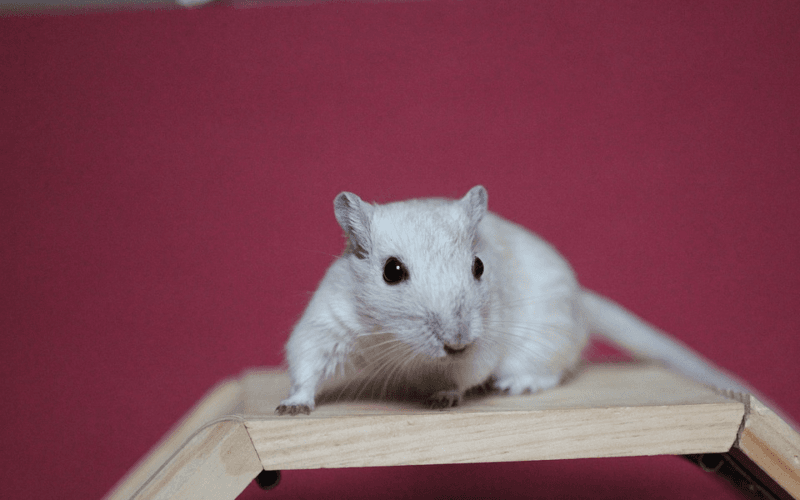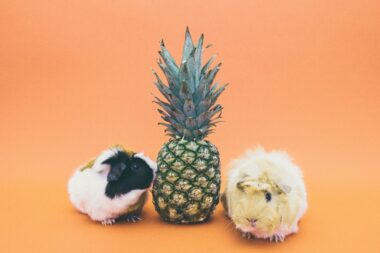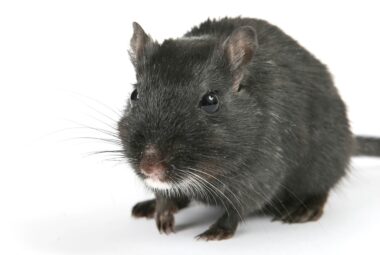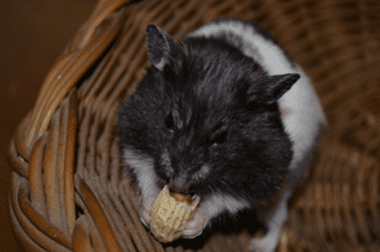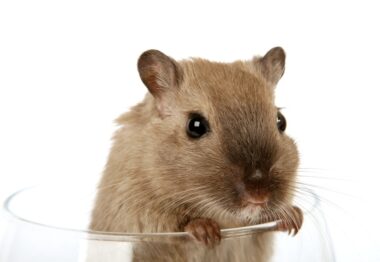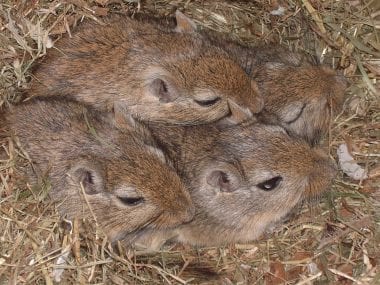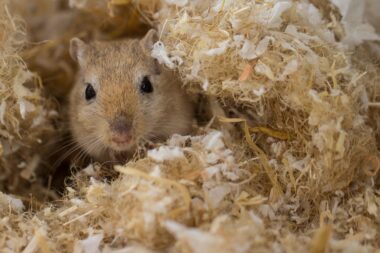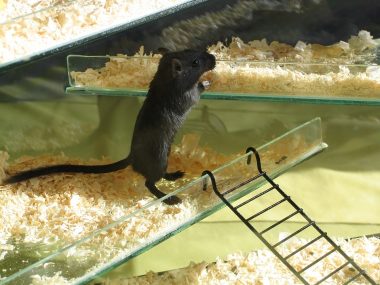Gerbils come in a wide variety of shapes and sizes, with 87 species and 14 genera now recognised. They are all members of the Gerbillinae mammalian subfamily, which was previously known as the desert rats. Asia, Africa, and India are home to the majority of these tiny critters.
Gerbils are now available for purchase in practically every pet store, with the exception of California, where they have been forbidden to buy or keep as pets. In most locations, one could only keep two types of gerbils as pets out of all the other gerbils found around the world.
Other gerbils, such as the three white gerbils on the list, would make excellent pets but are only seen in their native habitats.
Do Gerbils Change Color?
Gerbils have the ability to change colour. Colour changes are frequently associated with advancing years. As a result, a gerbil’s pattern will become much more prominent, or hair will darken as it ages.
For example, nutmeg gerbils are a bit deeper and darker brown than agoutis gerbils. When these gerbils are young, their fur is slightly orange. As they grow older, their fur develops darker flecks that form a pattern.
This is a widespread trait among gerbils of all kinds. Their fur will just be lighter while they’re young than when they’re adults. As they mature, their adult colour will emerge.
Gerbils’ colours change as they age, from adulthood until old age. A gerbil’s fur will get ‘diluted’ as it ages. This means it won’t be as brilliant as it used to be. This is, once again, nothing to be concerned about. It’s a normal aspect of growing older.
A gerbil entirely changing colour is something you won’t notice. As a result, your pet will not transform from an agouti to a lilac. It will not shift from white into black, nor will its eyes change from black to red or pink. Rather, fascinating gerbil hues are the result of selective breeding.
About White Gerbils
Many creatures have a colour and pattern in their natural state, although they appear white. When this happens, the animal is almost always albino. Albinism is caused by a genetic abnormality that causes the loss of melanin. People can also experience the same genetic alteration. White gerbils are available, with pink or red eyes similar to albinos. They aren’t albino, though. Rather, various, intricate genetic alterations are responsible for the shift in coat colour.
The gerbils in this picture are completely white. They resemble lab mice but are shaped like gerbils. Shades between a typical agouti and white, such as cream or nutmeg, are also available. White gerbils can have either pink or red eyes. White gerbils featuring black eyes are also available. BEWs (black-eyed whites) is a good name for them. White gerbils can be found all over the United States, though not in every pet store.
Here are three well-known types of white gerbil that may be right for you:
Black-Eyed White (BEW):
This is exactly how it states, as this gerbil is white with black eyes. They may also have grey accents on their ear and nose tips, but their tail and feet remain pink. Black-eyed white rodents are extremely attractive, and while they are not especially prevalent, they are neither uncommon nor unheard of.
Typically, three methods are used to produce Black-Eyed White mice. The mixture of Fawn (Ay) plus extreme chinchilla dilution, more frequently referred to as Beige, is by far the most prevalent (ce). Beige is diluted to white when paired with any of the “orange” colours.
Obtaining both a Beige and Fawn mouse is the simplest way to generate BEW mice. Combine them and keep the most typical fawn-coloured progeny. They will generate a few BEW puppies if bred back or together to their Beige parent.
There is one drawback to this method of creating BEW mice. As is the case with all Fawn (Ay) rats, BEW mice generated in this manner virtually invariably have a weight issue. This condition can range from mild portliness to severe obesity. Regrettably, this not only affects the appearance of the mouse and also its fertility. Female BEWs must frequently be bred early, or they would never conceive.
As an intriguing side note, when BEW is paired with the Brindle gene, it produces remarkable effects. When Brindle and Beige are combined, the orange background colour becomes white, but the dark stripes remain unaltered. As with white tigers, the offspring mice are white with black stripes and black eyes. They are sometimes referred to as Silver Brindles.
Additionally, dominant spotted rodents can make BEWs in another manner. When two variegated mice are bred together (Ww), one-quarter of the litter will be (WW). Unfortunately, the majority of WW rodents are born anaemic and die within several days. Occasionally, however, you will receive one that does not, and upon hair growth, you will learn that it is a BEW.
Pink Eyed White (PEW):
This gerbil is all white from head to tail. The eyes are a lovely pink colour, and pups will seem pink in comparison to their white fur until it grows in.
Pink Eyed Whites are completely white except for their pink eyes. The pp and double c[h] help to whiten the fur.
Pigment: Pink is the colour of the eyes. The skin will remain pink for a time until the white fur develops.
Fuzz: It will get completely white.
Pink-Eyed Whites-like Frosty, have quite a long and illustrious history in the world of rats. Albino rats (formally known as PEW-Pink-Eyed White gerbils) are most certainly also the first mutation to be found and purposefully produced. Albinism is a fairly common mutation in natural populations. It affects a wide variety of species, including ferrets, rabbits, cavies, dogs, and horses, as well as rats and mice. Naturally, these animals’ pink eyes and white coats would make survival in the wild extremely difficult. However, if discovered by an animal enthusiast, a strangely coloured white rat may have been rehabilitated rather than murdered.
A PEW-Pink-Eyed White should be completely white. A very excellent example does not have a yellow tint to the coat, discolouration of the undercoat, or stains. This may seem straightforward, and when you see a truly beautiful PEW, you realise that 99 per cent of what is available is actually ivory or cream-coloured.
While these are not actually Albino rats, these species are virtually identical to them. However, they are not genetically identical. If one of these rats is bred to an Albino rat or if two of these rats are bred together, colourful spot offspring will might come up. By the way, reproducing for less and less colour is how BEW-Black-Eyed White gerbils are formed, and Odd-Eyed White gerbils can be created in the same manner. True Albinos are Pink-Eyed White gerbils bred for the show ring.
Pink-Eyed White x Siamese will produce an all-Himalayan litter. That’s how Himis are created. But please remember that using a genetically Hooded PEW would result in a litter of offspring with no colour on their feet and potentially none on their tail.
Dark Tail White (DTW):
This variety is pretty much identical to the (PEW) version, with the exception that when they reach the age of 4 to 6 months, the tail will begin to darken. The colour of their tail appears to be brown or grey at this point.
Except for the black tail, the DTW-Dark Tail White is virtually entirely white. Around the time period of 4 to 6 months, the tail continues to darken.
The eyes of the gerbil are pink in colour. Before the white fur develops, the skin will be pink and will remain pink for a time.
Fuzz: It will turn completely white.
6 to 12 months: At that point, the tail will start to become a brown/grey tint. It’s hard to predict whether a baby PEW will become DTW before that time. (With the exception of parental genetics)
Which Gerbil Color Is the Rarest?
Honestly, there is particularly no such thing as the rarest colour, pattern, or colour and pattern combination. That’s because the definition of ‘unusual’ differs depending on where you reside. Some gerbil species are uncommon in some areas, whereas others are more widespread.
As a result, golden agoutis can be found almost anywhere. They may be found in practically any pet store. Apart from that, the colour or pattern you’ll come upon is purely random. Which is more common is determined by the breeders in your area.
Also, ‘rare’ does not always imply ‘excellent.’ The excessive white gerbil is a type of gerbil with a coat that is 90 percent white. This white gerbil is pristine and clean, unlike many other white gerbils. One might want one because they’re one-of-a-kind and unusual.
Summing Up:
No matter what colour they are, Gerbils are adorable and offer joy. Trying to take care of them could help you relax and feel less stressed. According to certain research, seeing them for a long period might provide you with a sense of calm. They, like other pets, have requirements for which we must cater. Taking care of pets, no matter how small or big, is a great job, hence why you must be prepared to handle all of them.
